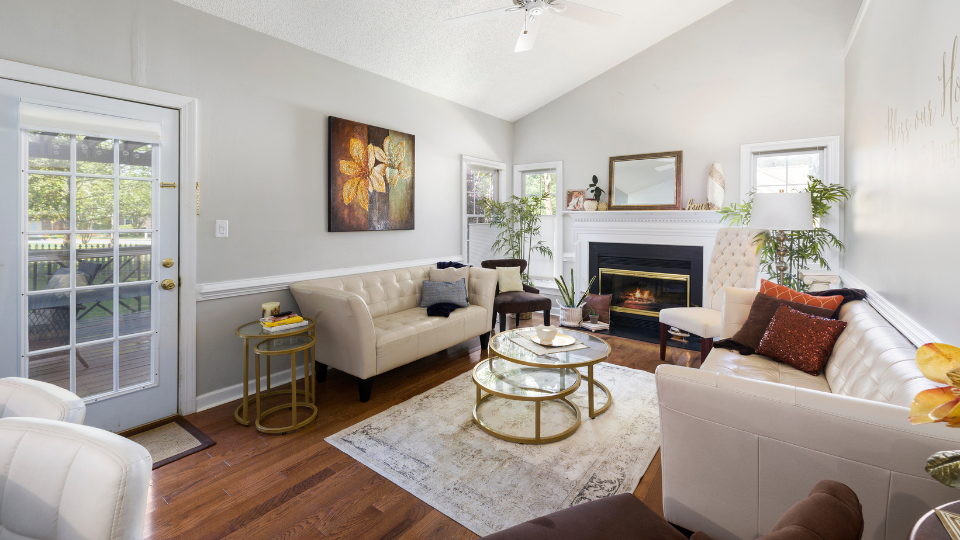When you decide to put your home on the market, one of the key moments in the selling process is the showings. Showings allow potential buyers to walk through your home, inspect every nook and cranny, and determine if it feels right for them. This often becomes the moment when a buyer falls in love—or walks away. Because of that, it’s critical for any homeowner to make a strong first impression. Whether you’re working with a real estate agent or selling your home by yourself, it’s vital to have a thorough plan to prepare for every showing. If you’re hoping to keep prospective buyers engaged and eager to submit an offer, you’ll need to roll out the red carpet and make your home stand out. Below, we’ve compiled the top pre-showing essentials to help you give your home the spotlight it deserves.
Start with a Detailed Decluttering Plan
The first, and perhaps the most critical, step when preparing your home for showings is to declutter. Clutter can be incredibly distracting for potential buyers, who should be focusing on the overall flow, functionality, and livability of your home. Instead of noticing your home’s best features—like the gleaming hardwood floors or recently renovated kitchen—they might become sidetracked by stacks of paper, overflowing closets, or random knick-knacks on every surface. Clutter, unfortunately, prevents potential buyers from visualizing themselves living in the space.
How to Tackle Decluttering
A great way to begin decluttering is by sorting your possessions into four main categories: keep, donate, toss, or store. Here’s a quick breakdown:
- Keep: These are essential items you’ll use regularly or immediately need during the home-selling period.
- Donate: Items still in good condition but no longer serving you can be dropped off at a local charity. This not only frees up space but can also help someone else.
- Toss: Anything irreparably broken, worn out, or beyond its shelf life should be thrown away.
- Store: Seasonal items, old memorabilia, or anything that doesn’t currently have a place in your daily life should be packed safely and stored off-site, if possible. If you don’t have extra space in your home, consider renting a small storage unit during the showing period.
Room-by-Room Strategy
Going room by room can ensure you don’t miss any essential spots. For instance, start with the living room, clearing off coffee tables and side tables. Next, head to the kitchen, where counters should be largely empty, and pantry space should look neatly arranged. Then tackle bedrooms, removing anything that doesn’t absolutely need to be out in plain view (stacks of books, old clothes, mismatched accessories, etc.). Continue this pattern through each area of your home, including garages, basements, and attics. The finished effect should leave your home appearing organized and open.
Embrace a Top-to-Bottom Deep Clean
After decluttering, the next essential is a thorough cleaning to ensure that every corner of your home shines. Cleanliness has an astonishing impact on a potential buyer’s perception. Even minor details like dusty ceiling fans or moldy caulk can dissuade someone from making an offer, since it signals a broader lack of upkeep or maintenance.
Checklist for a Proper Deep Clean
Consider creating a comprehensive cleaning checklist, taking you from the highest points of your home to the lowest:
- Ceilings and Light Fixtures: Use a microfiber duster or vacuum attachment to clear away spiderwebs and dust. Clean any light fixtures, fans, and vent covers.
- Walls and Baseboards: Wipe down your walls to remove scuff marks and smudges. Pay special attention to high-traffic areas like hallways and around light switches. Finish by thoroughly cleaning baseboards, as dust can accumulate there quickly.
- Windows and Mirrors: Potential buyers will look out your windows to see the neighborhood or backyard. Make sure windows are streak-free, inside and out. Polish mirrors in bathrooms and bedrooms until they shine.
- Kitchen: Cabinets, backsplash tiles, countertops, and appliances all deserve careful attention. Degrease stovetops and hoods. If possible, remove small appliances from counters to expand the sense of space.
- Bathrooms: Scrub grout, wipe down glass shower doors, and disinfect every surface, including toilets and sinks. Make sure towels are fresh and neatly folded.
- Floors and Carpets: Vacuum carpets thoroughly and consider professional carpet cleaning if they’re stained or have lingering odors. Mop hard floors to ensure they have a polished look.
- Furniture and Decor: Dust and polish any wooden furniture. Remove smudges from glass tabletops. Vacuum or lint-roll upholstered pieces.
- Odor Control: Pay special attention to odors, as unpleasant smells are a big red flag. Deep clean rugs, pet areas, and trash cans. Place discreet air fresheners or scented candles (with a mild fragrance) to keep your home smelling fresh—but avoid anything too overpowering.
Perfect Your Curb Appeal
Before buyers even step inside your home, they form an impression from the front curb. This is your chance to create an inviting, warm welcome. If your exterior looks neglected, buyers might assume the interior is similarly uncared for, potentially discouraging them from entering. On the other hand, a well-manicured lawn, tidied-up driveway, and bright entryway can send a positive message about how you’ve cared for the property.
Curb Appeal Essentials
- Lawn and Landscaping: Begin by mowing the lawn, trimming any overgrown hedges, and pulling weeds. If you have flower beds, refresh them with new mulch or decorative stones. Add pops of color with seasonal flowers or potted plants near the doorway.
- Exterior Cleaning: Power wash any outdoor surfaces, including siding, fences, and decks. Clean the gutters and remove any cobwebs from corners of the porch. Make sure the driveway and walkways are clear of debris.
- Front Door Update: A fresh coat of paint can work wonders on your front door, especially if the current one is faded. Complement it with modern house numbers, a clean and functional door handle, and a stylish but neutral doormat.
- Outdoor Lighting: Clean or replace light fixtures, and ensure all bulbs are working. A well-lit exterior is both safer and more welcoming, especially for evening showings or open houses.
Stage Your Home Strategically
Home staging revolves around highlighting your home’s best features while creating a neutral and inviting environment that buyers can imagine living in. Skilled stagers will often rearrange furniture, add tasteful decorations, or remove unnecessary items to make rooms appear bigger, brighter, and more welcoming.
Room-by-Room Staging Tips
- Living Room: Arrange furniture to create intimate conversation areas, leaving enough open space to walk around comfortably. Consider neutral-colored throw pillows or rugs for a polished look.
- Kitchen: Clear off the counters of almost everything except perhaps a bowl of fresh fruit or a neat coffee station. Store away items like kitchen utensils, small appliances, and magnets on the refrigerator that can make the area look cluttered.
- Dining Room: A simple centerpiece—a vase of fresh flowers or a small decorative bowl—can tie the space together without overwhelming it. Make sure the table is wiped clean, and chairs are arranged neatly.
- Bedrooms: Keep bedding neutral, fresh, and wrinkle-free. Remove personal items, such as family photos, to help buyers envision their own lives in the room. Limit decorations to one or two statement pieces of art, and ensure adequate lighting near the bed.
- Bathrooms: Another place to remove personal items (toothbrushes, hair products, makeup, etc.). Use fresh towels in a neutral tone. A small plant or neatly arranged decorative items can breathe life into the space without making it look cluttered.
- Home Office: Given the rise in remote work, a designated home office can be a major selling point. Keep the desk area clean and organized. Hide cables, cords, and personal documents.
- Outdoor Spaces: If you have a deck or patio, stage it with a modest outdoor furniture set and maybe a potted plant. You want buyers to picture themselves relaxing outside or hosting friends.
The Role of Furniture Placement
Strategic furniture placement is key to making your spaces feel bigger and more functional. Avoid pushing pieces up against every wall. Instead, try floating couches and chairs towards the middle of the room to create a flow of movement around them. This tactic often makes rooms feel more expansive.
Light It Up: The Right Lighting Strategy
Dark, poorly lit spaces can feel dreary and small. By maximizing both natural and artificial light, you can significantly improve the atmosphere of your home during showings. Adequate lighting brightens a space, makes it seem more inviting, and highlights its features and architectural details.
Maximizing Natural Light
- Window Treatments: Replace heavy curtains with sheer or lightweight drapes to allow more sunlight to enter. If privacy isn’t a huge concern in certain rooms, leave curtains pulled back or even removed to let as much light in as possible.
- Clean Windows: As mentioned earlier, thoroughly cleaning your windows can enhance the flow of natural light.
- Mirrors: Well-placed mirrors can bounce sunlight around a room, making it feel brighter. Consider placing a mirror opposite a window.
Strategic Artificial Lighting
- Layer Lighting: A combination of ambient, task, and accent lighting creates a welcoming environment. In living rooms, for example, use a ceiling fixture (ambient), a floor lamp near a reading chair (task), and a table lamp or accent lights to highlight artwork (accent).
- Match Bulbs to the Mood: Choose bulbs with the right color temperature—usually warm white for living areas and bright white for kitchens and bathrooms.
- Remove Broken or Outdated Fixtures: Any flickering or outdated fixtures can make a space look tired. Consider affordable, modern replacements to quickly update the feel of a room.
Neutralize and Depersonalize
One of the best ways to help buyers picture themselves in your home is by neutralizing the color palette. While you may love your bright orange living room or deep purple bedroom, these colors can be polarizing. Neutrals like gray, beige, white, or cream offer a blank canvas that appeals to a broader range of tastes.
Depersonalize Strategically
- Remove Personal Photos: Family portraits, school pictures, or collages can distract buyers and hinder them from imagining themselves living in the property.
- Minimize Highly Personalized Decor: That collection of sports memorabilia or avant-garde art piece might not resonate with all buyers. Stow away excessive personalization for broader appeal.
- Subtle Stylish Touches: You don’t have to remove all forms of personality. A few tasteful items like a single piece of artwork or some decorative pillows can still add warmth and style.
Handle Repairs and Maintenance
Minor issues can leave a big impression. Even small problems like a dripping faucet, cracked tiles, or squeaky doors can make buyers wonder what else might be wrong with the home. Before scheduling any showings, address these simple fixes:
- Patch and Paint: Fill in nail holes or scratches on walls, and repaint as necessary.
- Repair or Replace Damaged Fixtures: Examine door handles, faucets, cabinet knobs, and light switches for damage or wear.
- Tend to Flooring Issues: If you have loose tiles or squeaky boards, address them. For carpets, repair any tears or stains.
Larger Maintenance and Upkeep
If there are more significant problems—like a leaky roof or outdated electrical systems—be honest with yourself about whether it’s better to fix them before showing the home. While some buyers don’t mind taking on minor fixes, major issues often deter them or lead to low-ball offers. If a prospective buyer knows they’ll need to invest in expensive repairs, it might become a deal-breaker.
Tame Your Pets—and Their Messes
Pets are beloved members of many families, but not everyone will share that sentiment upon entering your home. Some buyers might have allergies or simply prefer a pet-free environment. Even if your furry friend is the perfect companion, traces of pet hair, smells, or damage can turn off potential buyers quickly.
Pre-Showing Prep for Pet Owners
- Remove Pets If Possible: If you can arrange for a friend or family member to take your pet out during showings, this avoids any awkward run-ins between your buyers and your four-legged friend.
- Clean Pet Areas: Thoroughly vacuum rugs and furniture to remove pet hair. Wash pet bedding to minimize odors, and make sure litter boxes or cages are fresh and discreetly placed out of high-traffic areas.
- Repair Damage: Scratched doors, chewed baseboards, or any other pet-related damage should be fixed before showings.
Set the Stage with Subtle Scents
Smell is a powerful sense that can evoke both positive and negative responses. While an inviting fragrance might make a buyer feel at home, an overpowering odor or harsh air freshener can have the opposite effect. The goal is to create a neutral, pleasant scent that isn’t too artificial or overwhelming.
Finding the Right Balance
- Freshen the Air: Open windows for a few minutes each morning to allow fresh air to circulate. If the weather permits, keep some windows slightly open during showings (as long as security is not compromised).
- Use Natural Elements: Bowls of lemon slices, fresh herbs like rosemary or mint, or a simple bouquet of flowers can provide a subtle and inviting aroma.
- Avoid Overpowering Sprays: Strong chemical air fresheners can raise suspicions about what odors you might be trying to mask.
Create a Welcoming Atmosphere
Buyers should feel comfortable during their walkthrough. If it’s hot outside, make sure your air conditioning is set to a pleasant, cool temperature. If it’s winter, ensure the heat is on and the home feels cozy. A comfortable environment encourages buyers to linger and explore, rather than rush out because they’re too hot or cold.
Soft Background Music
Some sellers opt to play gentle background music—classical, jazz, or acoustic tunes—at a low volume to create a soothing ambiance. However, this can be a matter of taste, and some buyers might find it distracting. If you choose this route, keep the volume very low.
Add Simple Inviting Touches
A small bowl of wrapped candies near the entrance, a cold pitcher of water on a kitchen counter, or a thoughtful note welcoming visitors to your home can leave buyers feeling warm and appreciated. These small gestures can help them form a positive association with your property.
Double-Check Security and Privacy
Although it’s rare for something to go missing during a showing, it’s not impossible. Before you open your home to strangers, take simple precautions:
- Lock Away or Remove Valuables: Jewelry, cash, credit cards, and small electronics should be out of sight and secured.
- Secure Paperwork: Hide personal documents that might contain sensitive information. Store them in a locked cabinet or safe.
Confidential Information
If you have any personal paperwork like bills, mortgage statements, or medical information lying around, tuck them away. Buyers will be looking through closets and storage spaces, so be mindful of how and where you store private documents.
Final Pre-Showing Checklist
Even with the best preparation, those minutes just before a scheduled showing can make or break the buyer’s first impression. Try to arrive home at least 30 minutes before a showing to do the following:
- Open Curtains and Blinds: Let in as much natural light as possible.
- Turn On the Lights: In darker rooms or on cloudy days, a bit of extra lighting goes a long way.
- Wipe Down Surfaces: Quickly wipe counters, tables, and visible smudges on stainless steel appliances.
- Check Bathrooms: Make sure toilet lids are closed, fresh towels are in place, and personal items are tucked away.
- Adjust Temperature: Ensure the home is at a comfortable setting.
- Tidy Up Any Stray Items: Children’s toys, dog leashes, or last-minute clutter that pops up.
- Do a Sniff Test: Step outside for a moment and then re-enter to see if there are any lingering odors that need addressing.
Prepare Mentally to Vacate
Buyers often feel more comfortable exploring a home when the owner isn’t there. Plan to head out during showings, whether that means going for a short walk, running errands, or relaxing at a nearby café. Leave a note for your real estate agent with any important details or instructions, like turning off lights or locking certain doors.
Online Impressions Matter, Too
While this post focuses on prepping for in-person showings, remember that the majority of buyers will first see your home online. Make sure it’s photo-ready:
- Professional Photography: Investing in a professional photographer often pays off. They know how to angle shots and capture lighting to make your home look its best.
- Highlight Unique Features: If you have a spacious backyard, a sunroom, or a newly renovated kitchen, ensure these features take center stage in your photos.
Virtual Tours
Given recent trends, many buyers now prefer virtual showings or 3D tours before coming in person. Make sure the same preparation applies: declutter, clean, and stage thoroughly, because a camera can be even less forgiving than the human eye.
Gather Feedback and Adapt
Not every showing will lead to an offer, and that’s okay. However, every showing can give you valuable feedback to improve future ones. If you’re working with a real estate agent, ask them to collect and share buyer impressions. Common comments—like insufficient lighting or strong odors—can be addressed right away.
Ongoing Adjustments
If you notice recurring concerns, focus your efforts on fixing those areas. Maybe you need to touch up paint in the hallway or remove a bulky piece of furniture that makes your living room feel cramped. The faster you can adapt, the better your odds of landing the perfect buyer.
The Psychological Aspect of Showings
When you live in a home for years, you get used to its quirks and imperfections. However, potential buyers see everything through fresh eyes. Before a showing, try to walk through each room as if you’ve never seen it before. Does the layout flow? Is it visually appealing? Do the rooms look bright and airy? By shifting perspective, you can better identify areas that might need attention.
Less Is More
Don’t underestimate the power of minimalism during a showing. An overly decorated or heavily furnished room can make buyers feel suffocated or confused about the space’s purpose. When in doubt, remove an item or two. That extra space allows buyers to fill in the blanks with their own vision of the home.
Handling Multiple Showings and Open Houses
As the showing requests roll in, it’s crucial to maintain the clean, decluttered environment you’ve worked so hard to achieve. Designate a space—like a guest room closet or an off-site storage area—where you can quickly store personal items that would otherwise be left out in the open. Keep a vacuum or sweeper handy to deal with last-minute messes.
Staggering Show Times
If you’re lucky enough to have multiple showing requests in one day, see if you can coordinate times that give you a short break in between. This buffer allows you to do a quick refresh of the home—fluffing pillows, wiping surfaces, or removing any new clutter that may have accumulated.
Leveraging Professional Resources
If the idea of rearranging furniture and selecting decor feels daunting, consider hiring a professional stager. They can bring in accessories, art, and furniture to help your home appear more modern and spacious. While this service can be an additional expense, studies have shown that staged homes often sell faster and at a higher price.
Cleaning and Landscaping Services
If you’re short on time or energy to handle a full deep-clean or landscape overhaul, invest in professionals. A top-notch cleaning service can tackle everything from carpets to countertops, and a landscaping crew can quickly transform a messy yard into a beautifully manicured lawn.
Handyman Services
For minor repairs, sometimes a professional handyman can address a list of small issues in a single afternoon—freeing you up to focus on other showing preparations.
Keep Documentation Handy
If you’ve invested in renovations or upgrades, compile a list or folder documenting the work—receipts, warranties, or before-and-after photos. Buyers love knowing that improvements were done properly and professionally. This documentation can help instill confidence that your home has been well-cared for.
Transparency About Age and Maintenance
Keep a record of the age of major components like the roof, HVAC system, and appliances. Buyers often ask these questions, and having quick, accurate answers builds trust and credibility.
Emotional Detachment
Selling a home can be emotional. After all, you’ve built memories there. However, to succeed in this process, it’s important to see your home from a business perspective. Getting too attached to how things “should stay” can hamper your ability to stage effectively or accept constructive feedback from agents and buyers.
Staying Objective
When you receive feedback, try not to take it personally. Instead, treat it as actionable data you can use to make improvements. By staying objective, you’ll be more effective at showcasing your home in its best possible light.
Celebrating the Process
Preparing your home for a showing—especially with repeated or back-to-back visits—can be exhausting. Take a moment to celebrate each success, whether it’s positive feedback, a great open house turnout, or even the simple act of getting your home show-ready on a hectic weekday.
Reward Yourself
Small rewards—like treating yourself to your favorite takeout after a long day of cleaning and decluttering—can keep your motivation high during the selling process. Each step you take is getting you closer to the end goal: a successful sale.
Conclusion
Preparing your home for showings is often an extensive effort, but it can pay off in a big way. By creating a comfortable, clean, and inviting space, you enhance the chance that potential buyers will form a lasting, positive impression—and ultimately make an offer. Each step, from decluttering to staging and from improving curb appeal to fixing those nagging repairs, contributes to a holistic showing experience that resonates with buyers on both practical and emotional levels.
Start with a plan: declutter systematically, invest in a deep clean, then polish the exterior for irresistible curb appeal. Inside, create an environment that reflects both warmth and possibility—shining the spotlight on your home’s best features while offering a blank canvas for buyers to imagine their own lives. Don’t forget to maintain a comfortable temperature, stay on top of lingering odors, and always remove personal valuables. Be prepared to adapt based on feedback, and don’t shy away from professional help if you need it.
Ultimately, selling a home is a journey that merges practicality, aesthetics, and a dash of emotion. With the right pre-showing essentials in place, you’ll be well on your way to captivating buyers, receiving offers, and confidently moving toward the next chapter of your life. So, put in the effort now and relish the reward of a home that practically sells itself when the doorbell rings and the buyers step through the threshold. Remember, the moment someone walks in, they’re not just looking at walls and windows; they’re imagining a future filled with family gatherings, lazy Sunday mornings, or that perfect reading nook. When you set the stage properly, you’ll give them every reason to say, “I can see myself here.”
Show it off, and let the offers roll in!




